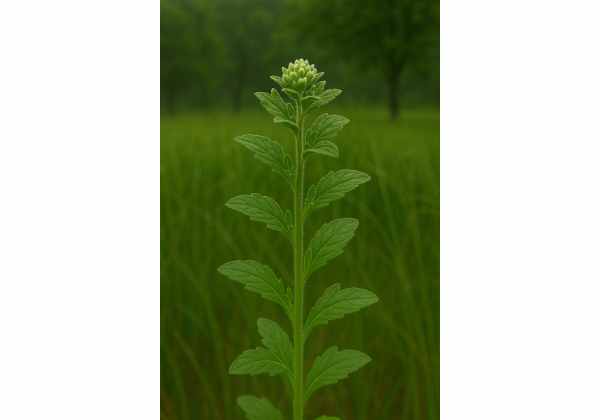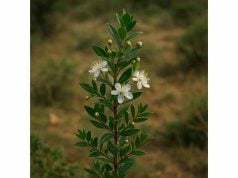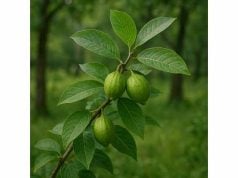
Marjoram is a cherished culinary and medicinal herb known for its warm, slightly sweet, and aromatic flavor. Rich in essential oils, flavonoids, and polyphenols, marjoram has been traditionally used to support digestion, relieve stress, and promote overall well-being. Modern research backs its antimicrobial, anti-inflammatory, and antioxidant properties, making it a valuable addition to both food and herbal medicine. Widely used in Mediterranean and Middle Eastern cuisines, marjoram is not only prized for its taste but also for its diverse therapeutic applications. Discover the comprehensive profile, active compounds, health benefits, and safe usage practices of this versatile herb in the sections below.
Table of Contents
- Botanical Overview and Identification
- Phytochemical Profile and Active Ingredients
- Health Benefits and Core Attributes
- Applications and Safety Considerations
- Scientific Research and Key Studies
- Frequently Asked Questions
Botanical Overview and Identification
Marjoram, botanically known as Origanum majorana, belongs to the Lamiaceae family—a group renowned for its aromatic and medicinal herbs. Native to the Mediterranean region, this perennial herb is cultivated widely across Europe, North Africa, and Western Asia. Characterized by its soft, gray-green leaves and delicate, white to pale pink flowers, marjoram exudes a subtle fragrance with hints of sweetness and spice. The plant typically grows to about 20–30 centimeters in height and thrives in well-drained, sunny locations with moderate watering needs.
The leaves of marjoram are oval, smooth-edged, and exhibit a slightly fuzzy texture that adds to its ornamental appeal in herb gardens. Its branching growth habit and low-spreading nature make it ideal for both culinary use and decorative purposes. The small flowers, which appear in clusters during the summer months, not only attract pollinators such as bees but also contribute to the herb’s mild, refreshing aroma. Marjoram’s robust adaptability allows it to flourish in diverse soil conditions, though it prefers a slightly alkaline pH.
Historically, marjoram has been revered for its dual role as both a flavor enhancer and a remedy for various ailments. Ancient cultures utilized marjoram in rituals and as a natural medicine to alleviate digestive disorders, respiratory issues, and even emotional stress. Its integration into culinary practices has evolved over centuries, and today, marjoram remains a staple in spice blends, stews, sauces, and marinades.
In addition to its culinary and medicinal values, marjoram holds cultural significance in many regions. It is often associated with notions of comfort and healing, symbolizing the warmth of home-cooked meals and traditional remedies passed down through generations. Modern horticulturists and herbalists continue to explore marjoram’s potential by studying its growth patterns, optimal harvesting times, and the effects of environmental factors on its chemical composition.
Understanding the botanical aspects of marjoram is crucial for both gardeners and healthcare practitioners. Accurate identification ensures that the correct species is utilized for its intended benefits. Whether grown in a backyard garden or sourced from organic cultivators, marjoram stands as a testament to nature’s ability to combine beauty with functionality, offering both aesthetic pleasure and a bounty of health-promoting properties.
Phytochemical Profile and Active Ingredients
The therapeutic potential of marjoram is underpinned by its rich phytochemical composition. Extensive research has identified a host of bioactive compounds in marjoram that contribute to its medicinal properties. Below is an exploration of the key active ingredients found in marjoram:
- Essential Oils:
Marjoram is renowned for its essential oil content, which includes compounds such as terpinen-4-ol, linalool, and borneol. These volatile oils are responsible for the herb’s distinctive aroma and contribute significantly to its antimicrobial and anti-inflammatory activities. Terpinen-4-ol, for instance, has been shown to inhibit the growth of various pathogens, making it beneficial for immune support. - Flavonoids:
This herb contains a variety of flavonoids such as apigenin, luteolin, and quercetin. Flavonoids are powerful antioxidants that protect cells from oxidative stress and inflammation. Their presence in marjoram enhances its capacity to neutralize free radicals, thereby reducing the risk of chronic diseases like cardiovascular ailments and certain cancers. - Phenolic Compounds:
Marjoram is rich in phenolic acids, including rosmarinic acid and caffeic acid. These compounds exhibit strong antioxidant properties, contribute to the herb’s anti-inflammatory effects, and support digestive health by promoting gut integrity and reducing oxidative damage within the gastrointestinal tract. - Triterpenoids:
Triterpenoids found in marjoram have demonstrated potential anti-cancer properties through their ability to induce apoptosis in malignant cells. They also support metabolic regulation and contribute to the overall anti-inflammatory profile of the herb. - Sterols:
Plant sterols such as beta-sitosterol, present in marjoram, aid in lowering cholesterol levels and improving cardiovascular health. These compounds work by blocking the absorption of dietary cholesterol, thereby promoting a healthier lipid profile. - Coumarins:
Marjoram contains small amounts of coumarins, which are known for their anticoagulant and anti-inflammatory properties. Their presence further supports the herb’s potential in managing conditions related to inflammation and blood clotting. - Vitamins and Minerals:
Although not the primary focus of marjoram’s health benefits, the herb also provides a modest amount of vitamins (such as vitamin C and several B vitamins) and minerals (including calcium, magnesium, and potassium). These nutrients contribute to overall cellular health and metabolic processes.
The synergy of these bioactive compounds makes marjoram a potent natural remedy with diverse health benefits. Advanced analytical techniques, including gas chromatography-mass spectrometry (GC-MS) and high-performance liquid chromatography (HPLC), have been instrumental in characterizing these compounds. The complex interplay between essential oils, flavonoids, and phenolic acids not only defines the herb’s aromatic profile but also underlies its therapeutic efficacy.
Marjoram’s phytochemical profile is dynamic and can vary depending on environmental factors, cultivation practices, and the time of harvest. Standardization of extracts is crucial for ensuring consistent therapeutic outcomes when marjoram is used in nutraceutical formulations or traditional remedies. This intricate chemical matrix underscores the herb’s capacity to support immune function, modulate inflammation, and promote overall health.
Health Benefits and Core Attributes
Marjoram has long been celebrated for its extensive health benefits, which extend well beyond its culinary uses. Its rich composition of antioxidants, anti-inflammatory agents, and antimicrobial compounds makes it a versatile natural remedy. Here, we explore the core attributes that render marjoram a potent contributor to health and wellness.
One of the primary health benefits of marjoram is its powerful antioxidant activity. The flavonoids and phenolic acids present in marjoram work synergistically to scavenge free radicals, thereby protecting cells from oxidative stress and damage. This antioxidant effect plays a crucial role in reducing the risk of chronic diseases such as heart disease, diabetes, and neurodegenerative disorders.
Marjoram is also known for its anti-inflammatory properties. Inflammation is a natural response to injury or infection; however, chronic inflammation can lead to a host of health problems. The bioactive compounds in marjoram help to modulate the inflammatory response, easing symptoms associated with arthritis, respiratory issues, and other inflammatory conditions. Its ability to reduce inflammation supports not only joint and muscle health but also contributes to a balanced immune system.
Digestive health is another area where marjoram shines. Traditionally used as a digestive aid, marjoram helps stimulate the production of digestive enzymes, easing symptoms of bloating, indigestion, and gas. Its mild carminative properties soothe the gastrointestinal tract, promoting healthy digestion and nutrient absorption. This makes it an excellent herbal remedy for individuals experiencing digestive discomfort or looking to support gut health naturally.
Beyond its digestive and anti-inflammatory benefits, marjoram has been associated with improved mental clarity and reduced stress. The calming effects of its essential oils are believed to alleviate anxiety and promote relaxation, making marjoram a valuable herb for mental wellness. Some studies suggest that the aromatic compounds in marjoram may help balance mood and reduce the physiological impacts of stress.
Marjoram’s cardiovascular benefits are also noteworthy. The herb’s plant sterols and antioxidants contribute to improved blood circulation, help maintain healthy cholesterol levels, and support overall heart health. By promoting vascular health, marjoram aids in reducing the risk of heart disease and supports optimal cardiovascular function.
In addition to these benefits, marjoram has antimicrobial properties that help combat infections. Its essential oils have demonstrated efficacy against various pathogens, which supports its traditional use in treating minor wounds and infections. This antimicrobial activity also makes marjoram a popular ingredient in natural oral care products and topical formulations.
In summary, the multifaceted health benefits of marjoram make it an exceptional herb for supporting overall well-being. From its antioxidant and anti-inflammatory properties to its role in enhancing digestion, reducing stress, and promoting heart health, marjoram offers a holistic approach to natural healing. Its integration into daily life—whether through culinary applications or herbal remedies—can help individuals achieve balanced health and improved vitality.
Applications and Safety Considerations
Marjoram is a versatile herb that finds applications in both the culinary and medicinal realms. Its pleasant aroma and flavor make it a popular addition to a variety of dishes, while its potent medicinal properties have earned it a place in traditional herbal remedies. Below, we detail the practical applications of marjoram and provide guidelines for its safe use.
Culinary Applications
- Herb Blends and Seasonings:
Marjoram is widely used as a seasoning in Mediterranean, Middle Eastern, and European cuisines. Its mild, sweet, and slightly peppery flavor makes it an excellent addition to soups, stews, sauces, and salad dressings. It is often blended with other herbs like thyme, oregano, and basil to create flavorful spice mixes. - Meat and Vegetable Dishes:
The herb enhances the flavor of roasted meats, poultry, and vegetables. Marjoram is commonly used to marinate meats or to garnish cooked dishes, imparting a subtle aromatic essence that complements savory flavors. - Infusions and Teas:
Marjoram can be steeped in hot water to produce a soothing herbal tea that aids digestion and promotes relaxation. This infusion is often enjoyed after meals to ease gastrointestinal discomfort and to support a calm state of mind.
Medicinal and Nutraceutical Uses
- Herbal Remedies:
In traditional medicine, marjoram has been used to treat a variety of ailments, including digestive issues, respiratory problems, and menstrual discomfort. Marjoram infusions and extracts are prepared to harness its anti-inflammatory, antimicrobial, and calming properties. - Dietary Supplements:
Marjoram extracts, standardized for their active compounds, are available in capsule or liquid form. These supplements are marketed to support digestion, enhance immunity, and promote overall wellness. - Cosmetic Formulations:
Due to its antioxidant and anti-inflammatory properties, marjoram is incorporated into skincare products. It is used in creams, lotions, and serums to help reduce the signs of aging, soothe irritated skin, and promote a healthy complexion.
Safety Considerations and Dosage Recommendations
- Moderation:
While marjoram is generally considered safe when used in culinary amounts, concentrated extracts or supplements should be consumed according to recommended dosages. Excessive intake may lead to digestive upset or allergic reactions in some individuals. - Quality Control:
Always choose marjoram products from reputable sources that adhere to strict quality control measures. Look for products that are certified organic or have undergone third-party testing to ensure purity and potency. - Consultation:
Individuals with existing medical conditions, those taking prescription medications, or pregnant and breastfeeding women should consult a healthcare provider before incorporating marjoram supplements into their regimen. This ensures that there are no contraindications or adverse interactions with other medications. - Allergic Reactions:
Although rare, some individuals may experience allergic reactions to marjoram. It is advisable to start with a small amount when trying a new product and to monitor for any signs of sensitivity, such as skin irritation or gastrointestinal discomfort. - Proper Storage:
Store marjoram in a cool, dry place away from direct sunlight to preserve its essential oils and active compounds. For dried marjoram, airtight containers are recommended to maintain freshness and potency over time.
By following these safety guidelines and dosage recommendations, marjoram can be effectively integrated into daily life, both as a flavorful culinary ingredient and as a potent natural remedy. Its broad range of applications makes it an ideal herb for those seeking to enhance both their diet and overall health through natural means.
Scientific Research and Key Studies
Recent scientific investigations have shed light on the myriad health benefits of marjoram, validating many of the traditional uses of this herb. Below is an overview of significant studies that highlight marjoram’s potential in various therapeutic areas:
- Antioxidant and Free Radical Scavenging (2014):
A study published in the Journal of Food Science and Technology demonstrated that marjoram extracts possess significant antioxidant activity. Researchers attributed this effect to its high polyphenol and flavonoid content, which effectively neutralized free radicals in vitro. The study suggested that regular consumption of marjoram could help reduce oxidative stress and lower the risk of chronic diseases. - Anti-Inflammatory Efficacy (2015):
In a clinical investigation featured in Phytotherapy Research, marjoram was evaluated for its anti-inflammatory properties. The study found that marjoram essential oil significantly reduced the production of pro-inflammatory cytokines in cell cultures. These findings support its traditional use in managing inflammatory conditions such as arthritis and respiratory ailments. - Digestive Health and Gastrointestinal Relief (2016):
Research published in the Journal of Ethnopharmacology explored marjoram’s effectiveness in alleviating digestive disorders. The study reported that marjoram extract improved gastrointestinal motility and reduced symptoms of indigestion and bloating. Its mild carminative properties were highlighted as key factors in promoting overall gut health. - Antimicrobial Properties (2017):
A study in Microbial Pathogenesis investigated the antimicrobial activity of marjoram essential oil against various pathogenic bacteria and fungi. The results showed that marjoram exhibited inhibitory effects against several microbial strains, suggesting its potential use as a natural preservative and in alternative antimicrobial therapies. - Neuroprotective and Cognitive Benefits (2018):
An exploratory study published in Evidence-Based Complementary and Alternative Medicine examined the neuroprotective effects of marjoram. The findings indicated that marjoram’s bioactive compounds might help improve cognitive function and protect against neurodegenerative disorders, likely due to their antioxidant and anti-inflammatory actions. - Hormonal Balance and Menstrual Relief (2019):
Research featured in Complementary Therapies in Medicine evaluated the effects of marjoram on hormonal balance and menstrual discomfort. The study suggested that marjoram could help alleviate menstrual cramps and regulate hormonal fluctuations, supporting its traditional use as a remedy for female reproductive health issues.
These studies provide a robust scientific foundation for marjoram’s traditional applications. The research highlights not only its antioxidant and anti-inflammatory capacities but also its potential to support digestive health, microbial balance, and cognitive function. As further clinical trials and investigations are conducted, marjoram is poised to become an increasingly important component in integrative health practices, offering a natural approach to preventing and managing various health conditions.
Frequently Asked Questions
What is marjoram and where does it originate?
Marjoram is a perennial herb belonging to the mint family, Lamiaceae, and is botanically known as Origanum majorana. It is native to the Mediterranean region and is widely cultivated in Europe, the Middle East, and North America for its culinary and medicinal uses.
What are the main health benefits of marjoram?
Marjoram is renowned for its antioxidant, anti-inflammatory, and antimicrobial properties. It supports digestive health, relieves stress, and may help alleviate menstrual discomfort, while also contributing to overall immune function and cardiovascular well-being.
How can marjoram be used in daily life?
Marjoram can be used as a seasoning in various dishes, added to herbal teas and infusions for digestive support, or taken as a dietary supplement in extract form. It is also utilized in skincare formulations for its soothing and antioxidant properties.
Are there any safety concerns or side effects associated with marjoram?
Marjoram is generally safe when consumed in moderate culinary amounts. However, concentrated extracts or supplements should be taken as directed, especially by pregnant women, individuals with hormonal imbalances, or those on medication. Consult a healthcare professional before starting any new supplement.
Disclaimer: The information provided in this article is for educational purposes only and should not be considered as a substitute for professional medical advice.
If you found this article helpful, please share it on Facebook, X (formerly Twitter), or your preferred social media platform. Follow us on our social networks for more updates on natural health tips and holistic wellness insights.










